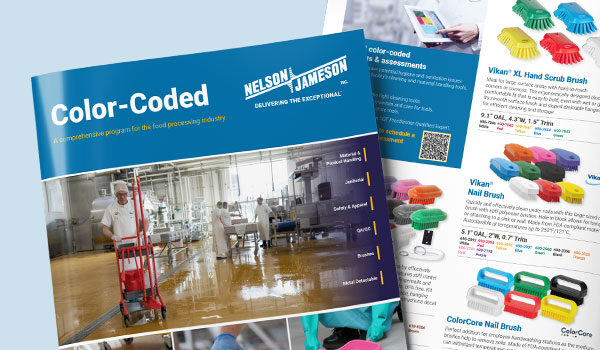 Significantly minimize food vulnerabilities with Nelson-Jameson's food defense product solutions! According to the FDA, food defense is defined as, "the effort to protect food from acts of intentional adulteration" (Food Defense, 2020, para. 1). Intentional adulteration could include various contaminations that are intended to cause harm to the public. In order to prevent and protect from harmful contamination, a food defense plan needs to be established. A food defense plan first consists of your facility completing a vulnerability assessment. This assessment is to determine where in the facility's processes pose the greatest risk for contamination. Second, mitigation strategies need to be selected for identified vulnerabilities, and lastly, corrective action needs to be implemented. Nelson-Jameson has products that are designed to assist with mitigation and preventative strategies within your facility and aid in your food defense plan:
Significantly minimize food vulnerabilities with Nelson-Jameson's food defense product solutions! According to the FDA, food defense is defined as, "the effort to protect food from acts of intentional adulteration" (Food Defense, 2020, para. 1). Intentional adulteration could include various contaminations that are intended to cause harm to the public. In order to prevent and protect from harmful contamination, a food defense plan needs to be established. A food defense plan first consists of your facility completing a vulnerability assessment. This assessment is to determine where in the facility's processes pose the greatest risk for contamination. Second, mitigation strategies need to be selected for identified vulnerabilities, and lastly, corrective action needs to be implemented. Nelson-Jameson has products that are designed to assist with mitigation and preventative strategies within your facility and aid in your food defense plan:
• Use color-coded personnel identification and badges to clearly identify authorized personnel around restricted locations, equipment, controls, and operations.
• Use tamper-evident devices, such as seals, covers, and locks, to secure openings, access points, equipment, and components, packaging, and storage containers.
• Clean and sanitize equipment components immediately prior to use and after maintenance.
• Use Clean in Place (CIP) cleaning chemicals and prescribed CIP procedures such as pre-rinse, wash, post-rinse, drain, and sanitize.
• Use one-way valves and sample ports to restrict access to product.
• Use coverings to secure openings, access points and open systems and operations such as shrouds, covers, lids, panels, and seals to restrict access to product.
After the assessment has been completed and you have determined the correct mitigation strategies, you can finalize your plan and determine its functionality. According to the USDA on the topic of functional food defense plans, the four main factors to determine the functionality of your plan includes:
Following the above strategies and functionality timeline can help you with starting to develop your facilities food defense plan. This strategic approach could potentially protect the entire food supply chain from an intentional chemical, microbiological, or physical contamination. Also, most food defense plans overlap with company's food quality and safety goals (Yoe et al., 2008). Nelson-Jameson has a wide range of products to help you aid in developing the food defense plan your facility needs. If your facility needs help in identifying which mitigation strategies are best suited for you, contact us today!
Sources:
Center for Food Safety and Applied Nutrition. (n.d.). Food Defense. Retrieved October 30, 2020, from https://www.fda.gov/food/food-defense
Functional Food Defense Plans. FSIS, USDA, 2 Aug. 2018, www.fsis.usda.gov/wps/portal/fsis/topics/food-defense-and-emergency-response/functional-food-defense-plan/functional-plans.
Yoe, Charles, et al. The Value of the Food Defense Plan. Food Safety Magazine, 2008, www.foodsafetymagazine.com/magazine-archive1/aprilmay-2008/the-value-of-the-food-defense-plan/.

December 10, 2025
What is OSHA's Regional Emphasis Program (REP) for the food manufacturing industry? The OSHA Regional Em...

December 8, 2025
There is a fundamental connection between worker safety and food safety: A failure in worker safety can ...

December 1, 2025
Nelson-Jameson understands that efficiency and worker safety are equally important goals in food manufac...

Recognize and address possible hygiene and sanitation challenges based on the cleaning and material handling equipment available in your facility.
Through a discovery call, virtual, or on-site assessment, Vikan SQF Practitioner certified specialists will assist in confirming that your system and cleaning tool inventory aligns with your risk management objectives while pinpointing any missing tools and enhancing maintenance and usage practices. Evaluate whether your existing tools are utilized in the most effective manner, or determine if a more suitable tool exists for the task at hand. Ensure that your tools comply with all relevant standards and regulatory requirements. Site evaluations encompass a summary survey, an overview of the location, a color-coded factory layout plan, product suggestions, a recommended order form, and a proposal for a follow-up survey.
Food Safety, Sanitation, Cleaning Tools, Color Coding

This is a comprehensive program for the food processing industry. Nelson-Jameson brings together the most extensive collection of color-coded products for material handling, product handling, janitorial, safety, apparel, QA/QC, and metal-detectable applications. With the right pieces, a color-coding system is a powerful tool in preventing cross-contamination of allergens and food-borne illnesses that can lead to sickness or expensive product recalls.

Food Safety, Sanitation, Cleaning Tools, Color Coding

Food Safety

Get Petrifilm Certified through our complimentary immersive workshop for managers, personnel, and teams. The workshop offers practical knowledge through hands-on training and networking with industry professionals and experts. Attendees gain an in-depth understanding of Petrifilm technology and valuable insights into effective environmental monitoring practices. Participants leave with a certification and a wealth of resources that can significantly contribute to elevating their plant's quality control standards.
Food Safety, Sanitation, Laboratory